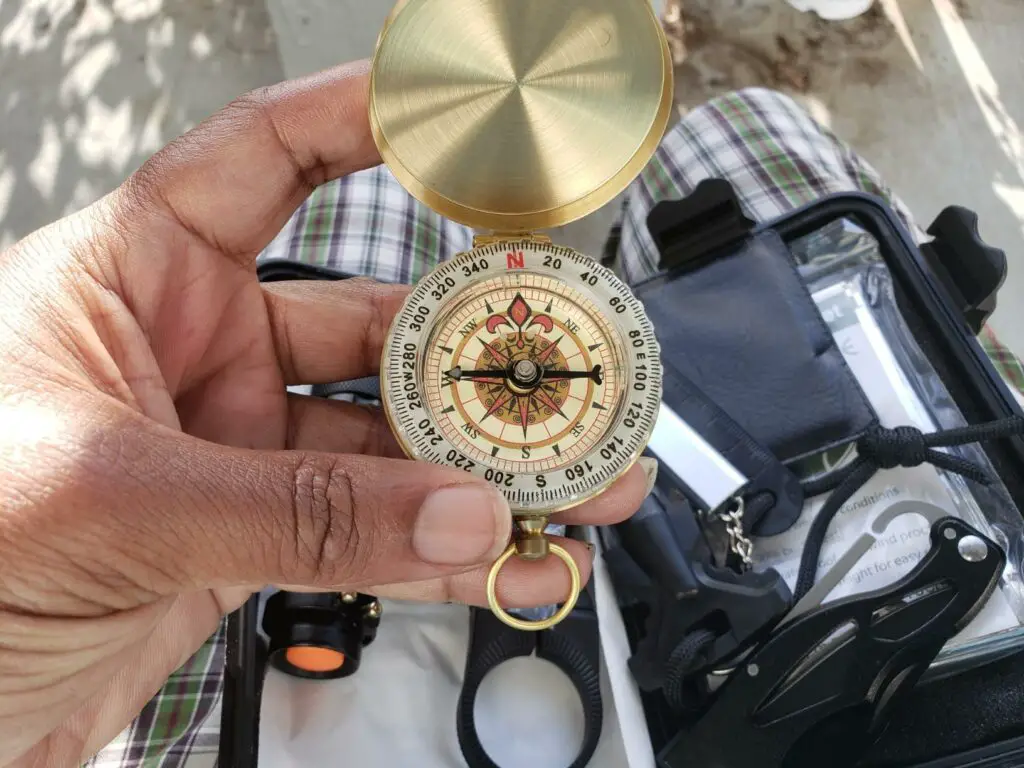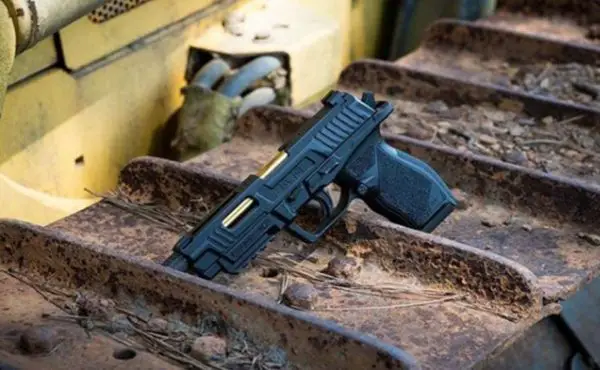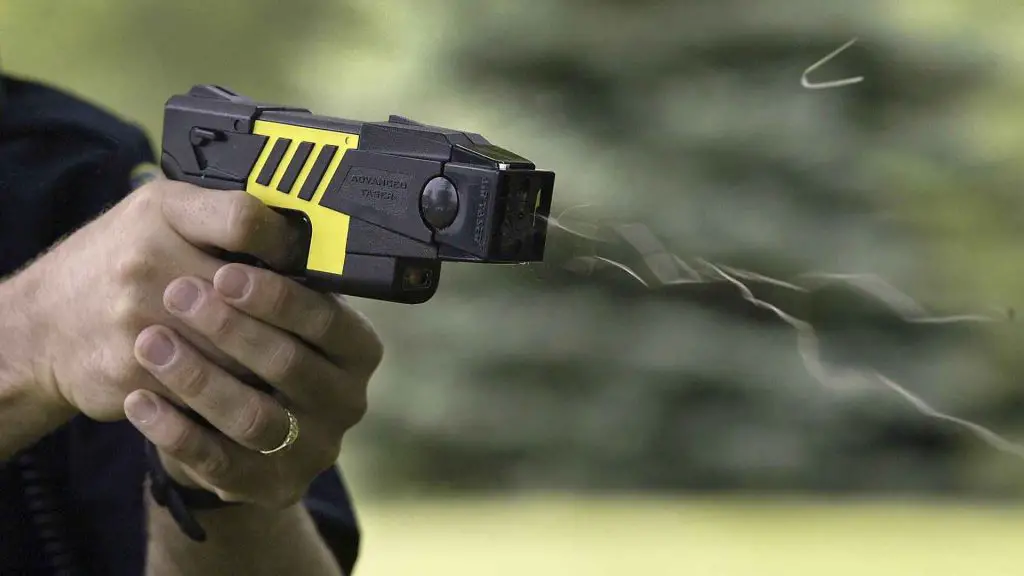
Non Lethal Home Defense: Zero-Casualty Protection
Protecting one’s home against intruders should always be a priority. The importance of home defense cannot be understated; of course, you want to guarantee the safety of your family, pets, and property.
Defending your home doesn’t mean you have to inflict death upon trespassers, no matter how much they may disrespect your privacy or disrupt your peace.
Thankfully, there are various non-lethal home defense solutions that will not cause fatalities, although they might leave intruders fairly bruised, battered, or burnt.
These solutions vary in terms of cost, ease of use or installation, and level of effectiveness.
When used appropriately, along with a firm understanding of their correct utilization, these methods and tools can be excellent deterrents against home invaders, whether they are of the human or animal kind.
Today, we will explain the different types of non-lethal home defense options currently available.
We will also look into the legal aspect of employing these solutions for self-defense, as well as the possible ramifications one will face if one uses them for purposes other than home protection.
Is Non Lethal Home Defense Even Possible?

Yes, non-lethal home defense is certainly possible.
Homeowners who are more resourceful than others may even readily claim that you can take a DIY (do-it-yourself) approach when it comes to non-lethal home defense.
Of course, we are not saying that you should go full Kevin McCallister and set up various traps or Rube Goldberg contraptions inside or around your house.
Our point is that less-than-lethal home protection is very much doable. In fact, there is a growing worldwide market for non-lethal defense weapons—this is proof that many people believe these solutions have become necessary.
But what are the reasons people go for non-lethal home defense options? Here are some of them:
Protect With a Clear Conscience
Yes, making sure your loved ones and belongings are safe should be your primary concern. But most people may not be prepared to take another person’s life, even in self-defense.
Having that on your conscience for the rest of your life could be a burden that is too heavy to bear.
Additionally, if you know that your self-defense solution will only do a bit of harm, you will not hesitate to act if you encounter an intruder in your home.
Any moment of hesitation, no matter how minute, could mean the difference between life and death.
Minimize Harm or Damage If Misused
No home defense solution is immune to accident or misuse. Pepper sprays could be misplaced and picked up by your child.
Blunt weapons are not likely to cause any deep cuts, but they can still fall from high places or trip you up if unintentionally left lying on the floor.
The good thing about non-lethal home defense options is that if they cause accidents, there is a good chance that the harm or damage done will not be severe or catastrophic.
Comfort and Ease of Use
Lethal weapons are as devastating as they come, chiefly because they tend to be more powerful, sharper, or heavier. For those reasons, you always need to get specialized training and take extreme caution when handling them.
On the other hand, most non-lethal home defense options are much more user-friendly. We are not saying all of them are as easy to wield as a baseball bat, but you can quickly learn how to use them after becoming familiar with their mechanics.
What Are Your Options for Non Lethal Home Defense?
Your non-lethal home defense options can vary depending on product type, the technology used, and of course, cost.
In terms of product type, you can choose between non-deadly devices that use electric shock (stun guns and tasers), chemical compositions ( pepper sprays), mechanical or kinetic force (batons or baseball bats), or even sound (hyper whistles and ultrasonic guns).
As for the technology used, you can go for high-tech solutions like home alarm systems that are typically more expensive.
Or you can opt for analog devices that do not run on electricity and do not have complex mechanical parts and sophisticated assembly.
To help you out, we have a list of the most common and readily available non-lethal home defense options you can take advantage of.
Sprays
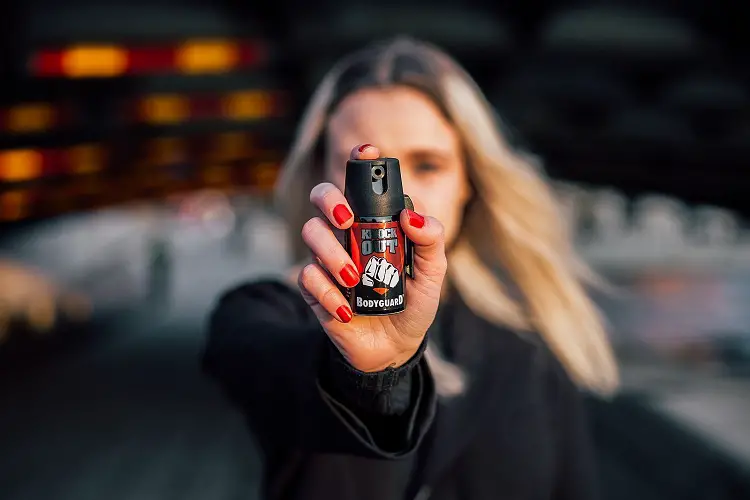
The most well-known self-defense spray is the pepper spray, which works by discharging a steady chemical compound burst that will irritate an attacker’s eyes.
Depending on how direct and how much of the chemical hits the eyes, it may cause severe pain, a burning feeling, or even momentary blindness.
If used correctly, the pepper spray can temporarily disorient the intruder for several seconds or minutes—some variants’ effects can last for half an hour or so.
A well-executed spray should give you enough time to get away or call for help, or if you can handle it, disarm or restrain the attacker.
Pepper sprays are quite common and easy to purchase. You can buy one from a pharmacy, hardware store, car accessory store, outdoor gear store, army/navy store, or sporting goods shop.
In terms of providing home defense, pepper sprays can be very effective, but they also come with disadvantages.
Pros and Cons of Pepper Sprays
Pros:
- Light, can fit easily inside a pocket or purse
- Available in many different stores
- Zero long-lasting effects
- No training required
- No physical contact needed
- Legal across the US
Cons:
- Sometimes don’t work on people on drugs
- Do not work if the attacker’s eyes aren’t exposed
- Windy or rainy weather might affect the trajectory
- With expiration date (approximately two years after manufacturing date)
Did You Know?
Other terms for pepper spray include pepper gas, mace, capsicum spray, capsaicin spray, oleoresin capsicum spray, or OC spray (or OC gas).
Blunt Weapons
As their name implies, blunt weapons or blunt instruments do their damage by inflicting blunt force trauma.
Sure, they might not cause gashes or deep wounds like knives and guns do. But with proper force and application, they can still inflict bruises, sprains, and fractures to deter a home intruder.
The most commonly used blunt weapons for non-lethal home defense purposes include batons (which come in collapsible versions), self-defense sticks like Kali or Escrima sticks, everyday household tools, and sports equipment.
Batons (also called billy clubs) and other self-defense sticks vary in price, material, and supply, so you may have trouble finding the exact one that will suit your needs.
Household tools are much easier to acquire. Technically speaking, any sufficiently durable or heavy, non-bladed household tool of decent size can be used as a blunt weapon.
You can easily choose from common handyman tools like a hammer, metal plumbing pipe, large monkey wrench, or gardening tools like a rake, shovel, or crowbar.
As for sports equipment, you can pick up a baseball bat (hardwood or metal alloy material), cricket bat, metal hockey stick, or golf club.
Pros and Cons of Blunt Weapons
Pros:
- Budget-friendly options (hammer, baseball bat)
- Easy availability (household tools can be used)
- Safer to use than blades and firearms
- Zero maintenance
- No specialized training required
Cons:
- Requires physical contact
- Wooden blunt weapons may break or shatter
Did You Know?
You can wrap your baseball bat with an old sock so that if an attacker tries to grab it from you, they will not be able to hold on to the bat.
Read Also: The Best Tactical Flashlights of 2021
Paintball Guns
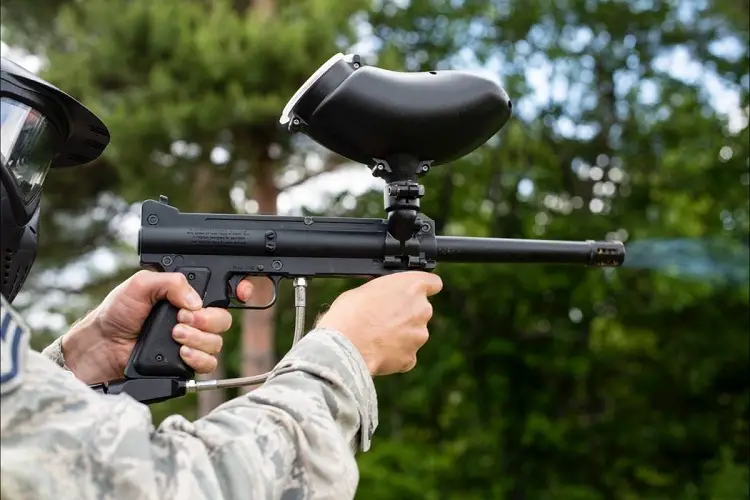
Paintball guns may not be real guns, but they can be used to good effect as a non-lethal home defense solution.
If you have ever played paintball games, you would know the real reason players have to wear the right protective gear.
For those who haven’t had the pleasure of participating in those games, let’s just say those pellets hit nothing like your average Nerf blaster.
The point is: Getting shot by a paintball gun can hurt very much.
If you have paintball guns in the house, use them wisely and with caution. The danger is in possible escalation, wherein an intruder sees your paintball gun, mistakes it for a real firearm, and then pulls out a gun he’s concealing.
Pros and Cons of Paintball Guns
Pros:
- Deterrent (some models appear like real guns)
- No physical contact needed
- Sturdy models can serve as blunt weapons
Cons:
- Shot accuracy is unreliable at times
- Bulky
- Cannot complete disable attackers
Stun Guns
A stun gun is defined as any device that produces a strong electrical charge that can hurt or immobilize a person.
It is a good example of an electroshock weapon, and it works by delivering a quick high-voltage electrical discharge when coming into contact with an attacker’s body.
Are stun guns and tasers the same?
Both are electroshock devices that are often mistaken for the other. Technically speaking, a stun gun can only administer its charge when touching its target.
A taser can be fired from a distance of a few feet, with its electroshock discharged through copper wires connected to its projectile darts.
Because of recent advances in technology, stun guns now come in more portable sizes, with versions designed to look like a cell phone, flashlight, or even keychain.
Pros and Cons of Stun Guns
Pros:
- Effective in disabling an attacker
- No long-term harm
- Easy to carry and conceal (variants come in cell phone size)
- Effective as a deterrent (capable of warning shots)
- Background checks are not required upon purchase
Cons:
- Requires direct contact (for stun guns)
- Potential for self-inflicted charge
Did You Know?
Stun guns that feature spiked prongs are more effective in disabling intruders who wear several layers of clothing than stun guns with metal plates.
Home Alarm Systems
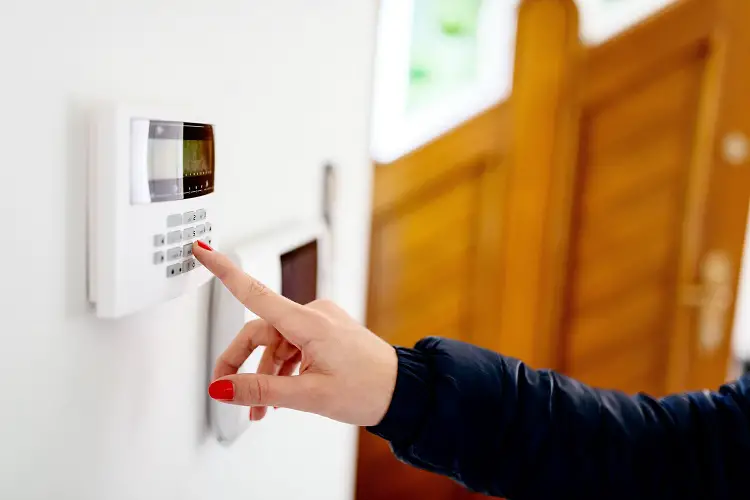
Home alarm and security systems consist of various security equipment and devices that function together to protect a home from intruders.
A great example of a sophisticated non-lethal home defense option, home alarm systems may consist of all or some combination of the following elements:
- Sensors or detectors (contact and motion sensors, smoke detectors)
- Keypad code entry technology
- Emergency button (panic button)
- Siren alarm and speaker systems
- Surveillance equipment (security cameras)
Home alarm systems also vary in terms of the specific electronic components used, but most typically serve the following purposes:
- Raise an alarm when security is breached
- Automatically notify authorities or 911 when tripped
- Commence lockdown or tighter security if it detects a threat
Pros and Cons of Home Alarm Systems
Pros:
- Deterrent against intruders (if signs or stickers are posted)
- Active human operation not required
- Can be used remotely (even when you’re not home)
Cons:
- Can be costly
- Most need professional installation
- Dependent on a power source
- Difficult to troubleshoot if it malfunctions
Did You Know?
With the latest advances in Internet and wireless technology, some home alarm systems now incorporate smart technology features and even artificial intelligence (AI).
Read Also: Best Wireless Security Cameras
How Legal Is Non Lethal Home Defense?

These non-lethal home defense options are legal in that most states do not have laws against the use or purchase of home alarm systems, paintball guns, stun guns and pepper sprays.
What about the issue of legal or criminal liability?
Across the US, states typically enforce self-defense laws that dictate that people who defend themselves or their loved ones against life-threatening elements will not be held criminally liable if they use “reasonable force.”
As long as these defense solutions are applied and used within the context of “reasonable force” and for the purpose of self-defense, they should not translate to any legal ramifications for the homeowner.
Now, if you are wondering what happens if your choice of a non-lethal home defense solution ends up killing an intruder, many factors need to be considered.
It must be determined whether or not “reasonable force” was used for self-defense, or the other extreme, whether or not the non-lethal defense option was used with clear intent to kill and succeeded in doing so (which clearly suggests intent to harm).
Is It Worth Investing Into a Safety Room?
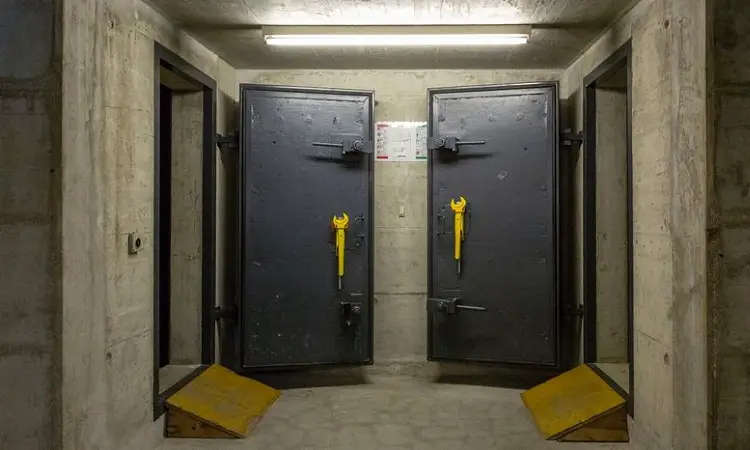
A safety room, also known as a panic room, is an impenetrable fortress within the confines of your home (or place of business) that you can run to if you experience a home invasion or are in the midst of a calamity.
A lot of planning and engineering goes into preparing a safety room, not to mention the amount of money you will be spending to build one.
So if you’re thinking of investing in a safe room as a non-lethal home defense solution, you need to seriously consider the following:
- If you or your loved ones can’t defend yourselves because of your age, a medical condition, or disability, then a safety room may be a necessity
- If you live in a city or country prone to violent crimes or in the midst of civil unrest (war, riots), and help is not readily available, then a panic room makes sense.
- If you live in a city or country prone to natural disasters like tornadoes or hurricanes, then a safety room can provide shelter when needed.
Conclusion
You can protect your home and your loved ones without resorting to lethal means. There are non-lethal home defense options that you can consider depending on your budget and preferences.
These options have their advantages and disadvantages, and you need to weigh the costs and benefits of each to determine which solution fits your requirements.
Resources:
